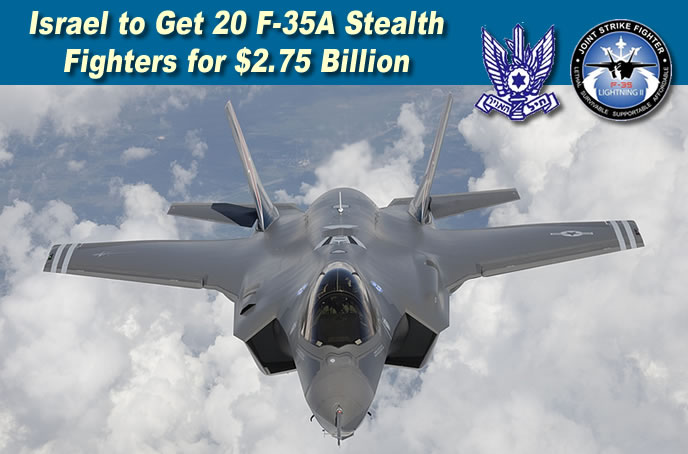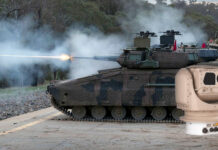
Israel’s defense minister Lt. General (Ret) Ehud Barak has given the go-ahead to a $2.75 billion purchase of 20 Lockheed Martin F-35I Lightning II fighter jets. The new fighter will be provided along with an integral support package, sustaining the aircraft through its service life. The decision has yet to pass the approval of the Israeli government. The purchase will be funded by U.S. military aid to Israel. Israel originally planned to buy 75 such planes, with an initial option of 25 aircraft. According to Israel MOD sources, the flyaway cost of these aircraft will be $96 million, but this cost reflects only the net platform price.

The expenses including the preparation of the new squadron, initial infrastructure, logistical and support package is expected eventually to exceed $150 million per plane. Given the additional integration cost of locally developed Israeli systems planned for integration into this highly complex aircraft, the cost is expected to rise significantly for the fully equipped F-35Is in following years. Furthermore, for these enhancement and adaptations Israel may have to rely on local currency funding, unlike the aircraft acquisition program that will be funded entirely by the annual U.S. aid amounting over $2 billion per year.
How Much it Really Costs?
What Price In July this year Canada has ordered 65 F-35As fora total amount of C$9 billion, reflecting a flyaway cost of $138 million. According to Lockheed Martin, the Canadian F-35A is configured as the least costly version of the aircraft offered at a cost of US$60 million per aircraft. The remaining amount reflect training, logistics and support costs. Israel is expected to opt for one of the more expensive versions of the stealth fighter, therefore it was priced slightly above the average cost of the F-35A (US$92.5 million). The manufacturer Lockheed Martin is offering the new fighter with turnkey life cycle support program. Although the cost and specific details of these support packages has not been announced yet, given the high readiness level required by the IAF, U.S. analysts have determined the estimated life cycle cost of the aircraft could reach up to $380 million.
Israeli pilots will begin training on the new aircraft by 2014 and the first aircraft are expected to arrive in Israel by 2015. The first squadron could become operational in less than two years at one of the Israel Air Force (IAF) southern air bases. Four Israeli pilots have already flew in the F-35 simulator in the U.S.A. The F-35 cockpit and avionics are not strange to the Israelis. Elbit Systems is the supplier of the advanced Helmet Mounted Display System (HMDS), which provides the pilot’s primary interface with the aircraft.
The decision marks the culmination of a debate within the Israel defense establishment about the high cost of the program. Some argued that committing such a large portion of the annual defense budget to a single acquisition program is not justifiable, and that Israel should seek less costly alternatives for the modernization of its air force, especially, given the changing priorities of Israel’s defense. Others claim that the fielding of the world’s most advanced fifth generation aircraft creates an important deterrence, while maintaining the IAF qualitative edge over its regional opponents. Another issue was the inclusion of indigenous Israeli systems in this Fifth Generation fighter aircraft.
The initial F-35I will represent standard F-35A models. However, the F-35I acquisition agreement is opening opportunities for the installation of Israeli systems in future production batches. These opportunities will also open the aircraft for marketing Israeli systems to other air forces, reflecting an opportunity worth several billions of dollars for the local industry. Maj. General (ret) Udi Shani, Director Israel of Israel MOD has stated that the acquisition agreement also includes a framework for buyback purchasing from the Israeli industry worth $4 billion. The introduction of Israeli components, systems and technologies into the world’s newest fighter plane will also open a potential market opportunity worth about $5 billion among the aircraft users.
New Opportunities for Israeli Systems
The airframe, subsystems and components for the current models of the F-35 – the land based F-35A, Carrier model F-35C and Short TakeOff Vertical Landing (STOVL) F-35B are all contracted, but some of the weapons systems are yet to be decided, and open future opportunities for the Israelis. Among these are the air/air missiles – the types currently considered for the F-35 are the U.S. made AIM-9X, and AMRAAM, and European ASRAAM and Meteor. The Israelis could opt for the Stunner missile (Python 6) under development under a joint venture between Rafael and Raytheon.
The Stunner will provide a common missile that could replace both AIM-9X and AMRAAM with a single missile. The missile is currently in development a surface-to-air missile, due for first deployment in 2013. Its specifications have already been set to enable carriage and operation by the F-35. Another weapon considered for the aircraft is the Spice guided weapon. These weapons will be instrumental for the stealth fighter’s ‘first day’ missions, where the networked-stealth fighters are expected to be penetrate and destroy enemy air defenses, paving the way for other strike fighters in their missions against airfields, air defenses, and enemy fighters, to achieve air supremacy. Currently RAFAEL is offering a 2,000 lb and 1,000 lb versions of the Spice, all these weapons can be fitted within the F-35’s internal weapons bay. The 500 lb version of the Spice, currently in development, could introduce multiple weapon carriage capability for the F-35, along with a full load of air-to-air missiles.
Communications systems will introduce another opportunity for the Israeli industry. To integrate within the Israeli command and control system the F-35I will have to carry suitable datalinks, satellite communications terminals and air to ground radios, to ensure integration with the IAF network centric system. The IAF may have to settle with the baseline systems, designed to maintain the aircraft low-observability. Yet the integration of local protocols and waveforms is mandatory for the long run, either on individual aircraft or over manned or unmanned support systems which could also offer interesting solutions for air forces facing the same challenge.
Another opportunity for the F-35 community is the employment of a new escort jammer developed by Israel. Israeli EW systems are often offered with full access to the Electronic Warfare techniques generator, while U.S. jammers often rely on highly classified operating modes restricting the export of such systems. If the Israeli stand-off jammer can be adapted to the F-35 stealth platform, it could provide an important capability that could be highly attractive for many F-35 users. The standoff ‘escort’ jammer is under development as part of collaboration between IAI/Elta and Rafael could, could be adapted for the F-35, it could offer an attractive capability which is currently unavailable for export.
















